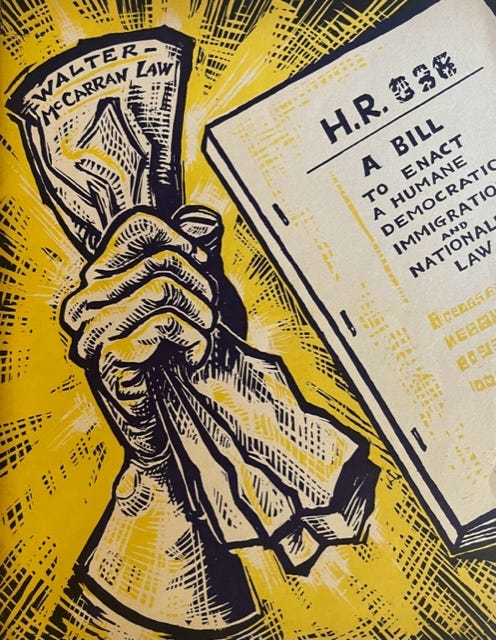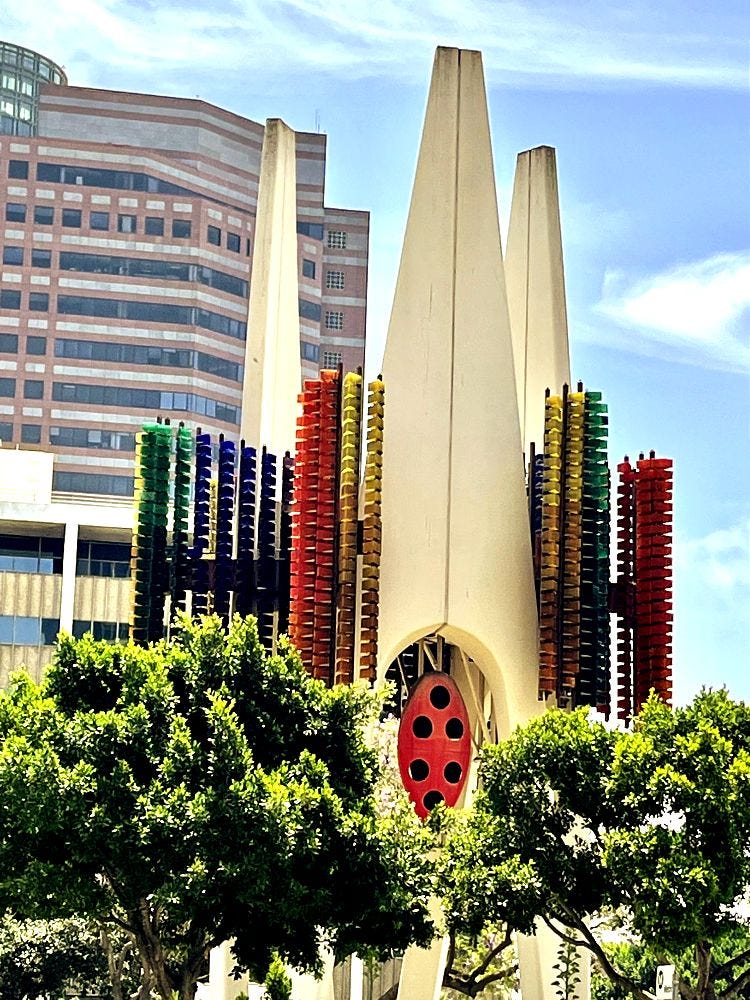Don't Bow Down
A New Scroll of LA Jewish News
Folks,
Jews aren’t much good at bowing down. It strains our "stiff necks." There are other reasons too. The Ten Commandments has some negative things to say about idol worship, and in the Book of Esther, the ruckus is started when Mordechai refuses to bow down to Haman. In prayer, we sometimes bow before God, but as some in America may think, including some of my coreligionists, Trump is no god; and despite the trappings of gold and crypto, he is not a king either. Yet, traffic on the streets of LA is thin, and the once busy commerce of the downtown flower mart is quieted, as if by some imperial decree enforced by a palace guard. Our neighbors, the people who grow our food, the folks we buy things from, who build our homes and help us to care for them, who take care of our elderly and our young, who send their children to our universities, are disappearing off our streets, as if King Ahasuerus had it written to be so. How does this awful lesson in imperial civics end? The end begins with not bowing down.
…Fortunately, MegilLA exists through no imperial decree. It continues through your free choice. These are times when we all need to hear a Jewish voice. Can you help this one continue? Please become a paid subscriber today!
Shabbat Shalom.
Edmon J. Rodman
////\/\\\\
////\/\\\\
Recalling the Holocaust
at a 'No Kings' rally
Edmon J. Rodman
The “No King” rally in downtown Los Angeles on Saturday, June 14, represented a battle on many fronts. Foremost, it was a battle against Trump and his immigration policies; a fight against being disappeared from family and friends.
But just as importantly, the tens of thousands of people who attended the largely peaceful demonstration were battling for recognition and even survival of their cultural identities in LA’s rich matrix.
On the edges of the crowd, street vendors, selling the flags of Mexico, Honduras, Guatemala, and the United States, were supplying much more than a piece of colored fabric to wave in the mid-day sun. They were selling the emblems of migration, history, and customs that were under attack.
For Jews, who had never been rounded up and deported from the streets of Los Angeles, the demonstration was a battle with memory. In the blue-sky California sunshine we needed to remember, that in the years leading up to WWII, Los Angeles was a place of Jewish sanctuary.
Thousands of German Jews who faced death at German concentration camps, some of them writers, artists, and intellectuals, such as the novelist Lion Feuchtwanger, found refuge here.
Standing in front of City Hall that day, among the poignant hand-worded rectangles, and banners held up for the crowd to see, it became easier to remember that Jews too had struggled with quotas, and seeking asylum; with dark crossings over borders.
We too were once grabbed up off the street, even murderously so, from countries to which we had long made contributions.
In sign after hand-made sign, that seemed to almost jump off their sticks, the underlying messages were “Don’t forget about us,” and “We have every right to be here.”
Though some of the placards supporting the Palestinian cause, many others
Connected the “No Kings” theme to Hitler, Nazis, and the Holocaust, demonstrating that the Jewish story was more than just a preface of the story being told.
One sign observed:
“History has a smell
I have smelled this before,
Berlin 1939
America 2025
Any difference?”
Though it is sometimes hard not see ICE as the Gestapo, yes, many differences. But there is one haunting similarity to today: In 1939 Berlin, the Nazis staged a lavish celebration of Hitler’s 50th birthday.
Another sign spelled out the German connection succinctly: “The Holocaust started as a mass deportation.”
“We support anybody who wishes to have a better life,” said the bearer of the sign, when I asked her what it meant to her. For Emily, who described herself as a Catholic Hispanic Mexican, the sign was realistic. “It’s true, she said. “The Holocaust began with deportation, and they are trying to repeat history.”
A third placard projected a clear connection to any Jewish Angelino present whose family immigrated to the U.S. before 1918 and perhaps even afterwards:“Your European great-great grandparents weren’t documented.”
Not only were many of our family members undocumented, but my own grandparents were poor and persecuted under the reign of essentially a despotic Russian king, Czar Nicholas II.
My wife’s Sephardic ancestors also had a bad experience with royalty, having been expelled, along with the rest of Spain’s Jewish population, by King Ferdinand II of Aragon and, Queen Isabella of Castile.
Awash in so much cultural history, it was so easy to step into the river of protestors marching down the street.
When German Jews had their time of crisis and persecution, and deportation, barely anyone had protested, or marched.
It felt good to be in the flow.
////\/\\\\
How Israelis are feeling
Israel Democracy Institute graphic
Edmon J. Rodman
While in the U.S. we nervously follow the ominous trails of Israeli and Iranian missiles as they zig and zag across our home screens, Israeli pollsters are tracking the opinions of their fellow citizens.
In search of an answer to “How does the Israeli public feels about the attack?” a recent poll by The Israel Democracy Institute found that 82% of the Jewish public supports Israel’s attack on Iran and the timing of the attack. Probably of no surprise, the poll also found that 65% of the Arab public opposes both the attack and the chosen timing.
Does the Israeli public feel that the attack was politically timed to serve Prime Minister Netanyahu’s political interests? According to the poll, some two-thirds of the Jewish public believe that Prime Minister Netanyahu’s motives for launching an attack at this time “were mainly objective and security-related.” However, two-thirds of the Arab public responded that his motives were “mainly subjective and political.”
Concerning personal danger during the war, the poll found that close to two-thirds of Jews are concerned about their physical safety as well as that of their families, while 89% of Arabs are worried or very worried about their safety.
When Jews and Arabs were asked about the length of the war, “close to two-thirds think that the war will end within a month or less.”
The survey was conducted by the Viterbi Family Center for Public Opinion and Policy Research at the Israel Democracy Institute between June 15–17, 2025. It was based on a representative sample of the population in Israel aged 18 and above, comprising 594 Jewish interviewees and 143 Arab interviewees.
The Israel Democracy Institute is a non-partisan think tank focused on bolstering the values and institutions of Israel as a Jewish and democratic state.
////\/\\\\
*LIVE FROM THE ARCHIVE:
When Jewish immigrants were the threat
Edmon J. Rodman
Sometimes a vintage piece resonates with the zeitgeist of the present.
In 1952, the U.S. Congress, in a move that can be seen as precursor of today’s immigration battles, passed, over the veto of President Truman, the McCarran-Walter Act, also known as the Immigration and Nationality Act of 1952.
At the time, many organizations representing immigrant interests, including those of Jewish immigrants, argued that the act eliminated numerous due-process safeguards shielding immigrants from deportation abuses.
The 48-page journal pictured above, with a striking graphic by Edo Mita, which gave voice to many of those immigrant groups. was published in 1956 by the L.A. Committee for Protection of Foreign Born.
The act, first proposed by Senator Pat McCarren (D-Nevada), was crafted during the Red Scare to maintain the status quo in the United States, and to safeguard the country from Communism, "Jewish interests", and undesirables that McCarren saw as threats to national security.
The final bill increased review of potential immigrants, stepped-up deportation, and added more stringent naturalization procedures.
Many Jews in LA, including the Emma Lazarus Jewish Women’s Club, supported the committee’s journal by taking out ads. They and others in the community viewed the act negatively because of its discriminatory national origins quota system and provisions that allowed for the exclusion and deportation of individuals deemed subversive like Jewish Holocaust survivors and those with leftist political views.
Included in the book are essays representing Mexican-Americans, The Jewish People, and Koreans.
Among the immigrant stories presented in the journal, one case may foreshadow things to come. A Los Angeles union organizer and worker, who was naturalized and had lived in the US for 34 years, was served a federal court complaint informing him that the government intended to take away his citizenship.
“Opposition to the law,” said one of the journal’s contributors, “has moved beyond mere protest at the fascist features of the law to an awareness that the political repressions in the law are also a major threat to the Jewish people.”
*The Rodman Archive of Los Angeles Jewish History is a collection of approximately 1500 objects, photos, clothing, art, books, recordings, and ephemera relating to the lives and endeavors of Jewish Angelenos between 1850 and 1980.
////\/\\\\
Seen on the way: Grand Park
Silently welcoming the downtown “No King” demonstrators, as they streamed into Gloria Molina Grand Park, was the king-sized multi-colored Triforium. The triangular 60-ton sculpture, designed by Jewish artist Joseph Young to glow in synchrony to music from a 79-note glass bell carillon, stood as an unofficial greeter to the thousands gathering to peacefully protest the expanding overreach of President Trump. Created by Young as a tribute to the unfinished kaleidoscopic nature of Los Angeles, it seemed a perfect usher for a demonstration aimed at bringing attention to a government bent on shattering the city’s fragile demography. One can only imagine how the sculpture might have responded to the day’s event if it were working. Would its 1494 triangular glass prisms flash yellow and red as a warning? Might it then flash green, giving a “go” to the demonstrators, ending the sequence with gradations of blue to relight a sense of hope.
////\/\\\\










